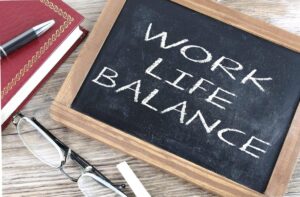Achieving a harmonious work-life balance can appear daunting. The industry’s complexity, 24/7 operations, and global interdependencies often lead to extended hours and high stress. However, prioritizing employee well-being is not just an ethical responsibility—it is a strategic imperative. Organizations that invest in work-life balance see higher retention, greater productivity, and a more resilient workforce.
This article explores why work-life balance matters in the supply chain industry and presents actionable strategies backed by real-world data and best-in-class examples.
The Demands of the Supply Chain Industry
Supply chain professionals face immense pressure due to volatile global markets, ongoing disruptions, and high consumer expectations. A recent survey by Gartner found that 63% of supply chain leaders believe their function is under increased pressure compared to pre-pandemic times (Gartner, 2023). Additionally, a Logistics Management report revealed that over 70% of logistics managers work more than 50 hours per week, often on-call during evenings and weekends (Logistics Management, 2022).
These intense demands can lead to mental fatigue, burnout, and reduced performance. According to the American Institute of Stress, 80% of workers feel stress on the job, and supply chain professionals are among the top quartile for stress-prone occupations due to unpredictable demand, supplier delays, and constant multitasking.
Proven Strategies for Promoting Work-Life Balance
1. Flexible Work Arrangements
Post-pandemic, companies like UPS and XPO Logistics have introduced hybrid work models for corporate supply chain roles. Flexibility to work remotely or on a compressed schedule has been shown to improve retention by 25% and reduce absenteeism by 18% (Gallup, 2022).
2. Clear Communication and Expectations
Companies that promote clarity—such as Procter & Gamble, which uses cross-functional planning meetings and digital dashboards—report a 15% reduction in overtime (Supply Chain Dive, 2023). When employees have visibility into timelines and task priorities, they manage their workloads more effectively.
3. Wellness Programs
DHL has implemented wellness initiatives, including onsite fitness centers, mindfulness apps, and stress management workshops. The result? A reported 23% drop in stress-related sick days across several of its hubs in North America (DHL Corporate Responsibility Report, 2023).
4. Encouraging Breaks and Paid Time Off
A Glassdoor study found that 55% of U.S. workers don’t use all their vacation time. Leaders in the supply chain industry, such as Maersk, are combating this by mandating minimum time-off policies. Encouraging disconnection not only supports well-being but also improves post-vacation productivity by over 30% (HBR, 2021).
5. Technology and Automation
Automation reduces manual workload, freeing up time for strategic thinking. For example, Amazon’s Robotic Fulfillment Centers have decreased human error by 30% and reduced shift overruns, according to a 2023 study by McKinsey & Company. The use of AI-powered forecasting and RPA (Robotic Process Automation) in demand planning is saving teams hours of redundant work weekly.
6. Cross-Training and Skill Development
Companies such as Caterpillar and Intel promote cross-functional training, which not only builds agility into teams but also helps employees step in to support one another during personal emergencies or peak workloads. A cross-trained workforce reduces individual burnout and boosts team cohesion.
7. Empowerment and Autonomy
Empowered employees are 67% more likely to stay at their current jobs for over three years (LinkedIn Workplace Study, 2023). Giving employees ownership of their decisions in areas like procurement and logistics routing increases morale and reduces stress levels, particularly when they’re not micromanaged during time-sensitive tasks.
8. Performance Recognition
Recognition increases employee engagement by up to 60% (SHRM, 2022). Companies like PepsiCo have launched internal social recognition platforms where supply chain employees are publicly acknowledged for innovation, efficiency, or team support—driving satisfaction and a culture of appreciation.
Tangible Organizational Benefits
Promoting work-life balance delivers direct business benefits:
- Reduced Turnover: The average cost of replacing a supply chain professional is over $30,000 (APICS, 2023). Firms prioritizing well-being cut turnover rates by 40%.
- Improved Productivity: Engaged employees are 17% more productive, and organizations with high well-being scores outperform competitors in revenue growth (Gallup Workplace Study, 2022).
- Attracting Top Talent: As Gen Z and Millennials dominate the workforce, 77% now cite work-life balance as a top priority when choosing employers (PwC Future of Work Report, 2023).
A Strategic Imperative
The supply chain sector can no longer afford to view work-life balance as a “nice-to-have.” It’s a competitive necessity. By cultivating a work culture that empowers employees to harmonize their professional and personal lives, companies can unlock higher levels of innovation, loyalty, and operational excellence.
Organizations that proactively embrace flexibility, well-being, and purpose-driven leadership will be the ones to thrive—not just in terms of performance, but in resilience, talent acquisition, and long-term reputation.
The Perfect Planner Team is here to support your organization in navigating work-life equilibrium in the supply chain. We offer free consultations tailored to your operational context. Reach us via LinkedIn, email us at info@perfectplanner.io, visit www.perfectplanner.io, or call 423.458.2979.
Author: Ed Danielov
Publication Date: June 19, 2025
© Copyright 2025 Perfect Planner LLC. All rights reserved.
References
- Gallup. (2022). State of the Global Workplace Report.
https://www.gallup.com/workplace/349484/state-of-the-global-workplace.aspx - Gartner. (2023). Supply Chain Priorities and Pressures Survey.
(Access may require subscription)
Summary: https://www.gartner.com/en/newsroom/press-releases/2023-03-06 - Logistics Management. (2022). Annual Salary & Career Survey.
https://www.logisticsmgmt.com/article/2022_salary_survey_supply_chain_pros_earn_more_despite_greater_workload - American Institute of Stress. (2023). Workplace Stress Statistics.
https://www.stress.org/workplace-stress - DHL. (2023). Corporate Responsibility Report.
https://www.dhl.com/global-en/home/about-us/sustainability.html - Supply Chain Dive. (2023). Workforce Strategy in High-Stress Supply Chain Roles.
https://www.supplychaindive.com/news/supply-chain-employee-retention-strategies/645778/ - Harvard Business Review. (2021). The Power of Time Off.
https://hbr.org/2010/01/the-power-of-time-off - McKinsey & Company. (2023). Warehouse Automation: ROI and Efficiency Gains.
https://www.mckinsey.com/industries/operations/our-insights/automation-in-logistics - SHRM. (2022). The Impact of Employee Recognition on Engagement.
https://www.shrm.org/resourcesandtools/hr-topics/employee-relations/pages/why-employee-recognition-matters.aspx - PwC. (2023). Future of Work and Workplace Preferences Report.
https://www.pwc.com/gx/en/services/people-organisation/global-workforce-hopes-and-fears.html - APICS (ASCM). (2023). Talent Retention and Cost of Turnover in Supply Chain Roles.
(Access may require ASCM membership)
Overview: https://www.ascm.org - LinkedIn. (2023). Workplace Empowerment and Retention Study.
https://business.linkedin.com/talent-solutions/blog/trends-and-research/2023/workplace-culture-trends






